This garlicky, lemon- and chili-spiked Shrimp linguine recipe is ready in 40 minutes or less, with a complex savory flavor that’s very restaurant-worthy. A dairy-free pasta recipe that’s easy enough to make on a weeknight but special enough to serve to dinner guests!
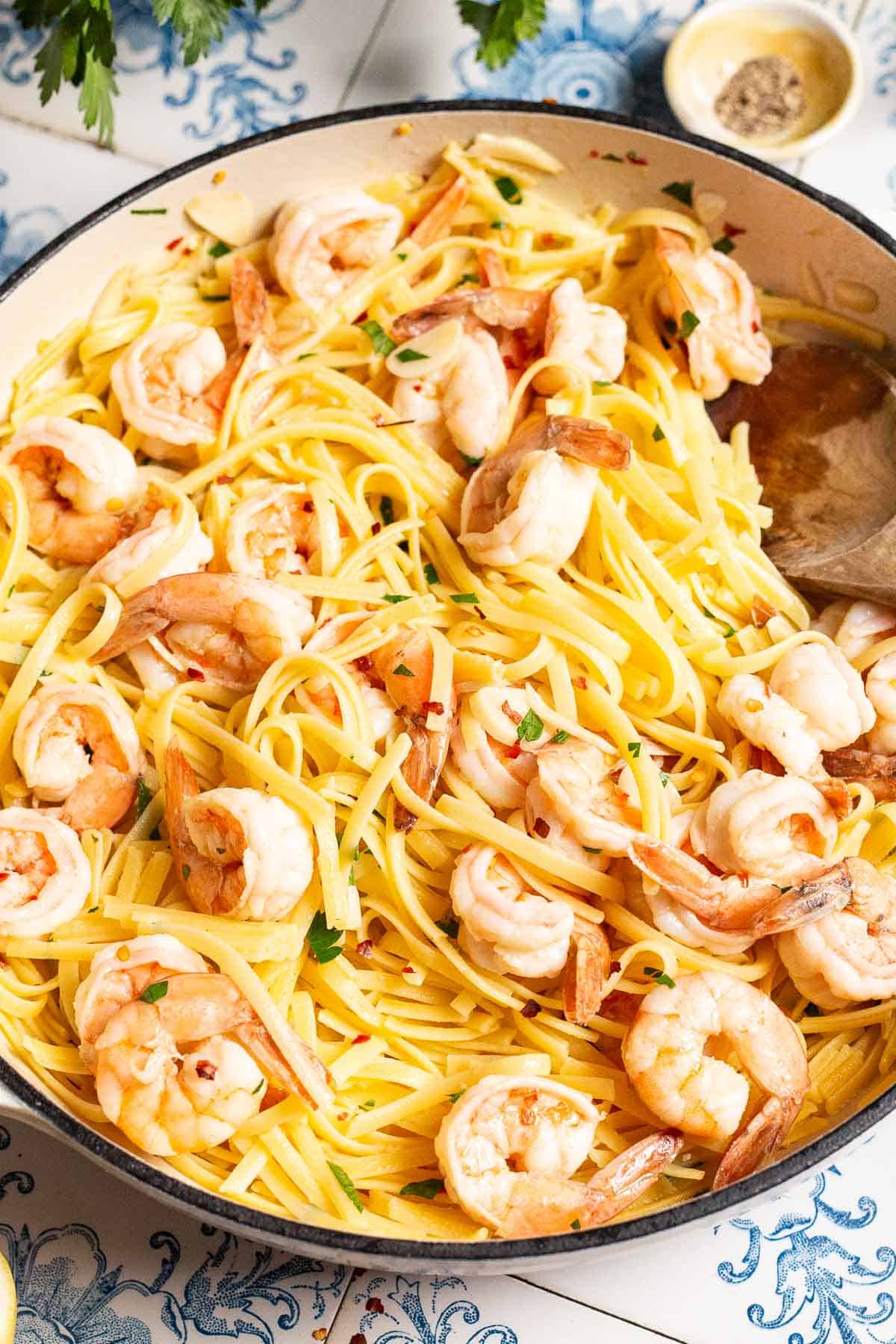
There’s a reason Shrimp linguine has become a classic: juicy shrimp and silky linguine are a match made in heaven.
In this version, large, juicy shrimp are cooked in a flavorful sauce of olive oil, garlic, lemon, red pepper flakes, and white wine, similar to Shrimp Scampi but with clam juice or Chicken Broth replacing the butter for an extra flavor boost. The word linguine translates to “little tongues,” a reference to the noodle’s flat shape, which beautifully soak up the lemon garlic sauce, and the shrimp contributes a lively splash of color and a delicate sweetness.
Serve this savory Shrimp Linguine recipe with Roasted Broccoli with Lemon and crisp white wine, and instantly transport yourself and your guests or family to the Mediterranean seaside for dinner.
Table of Contents
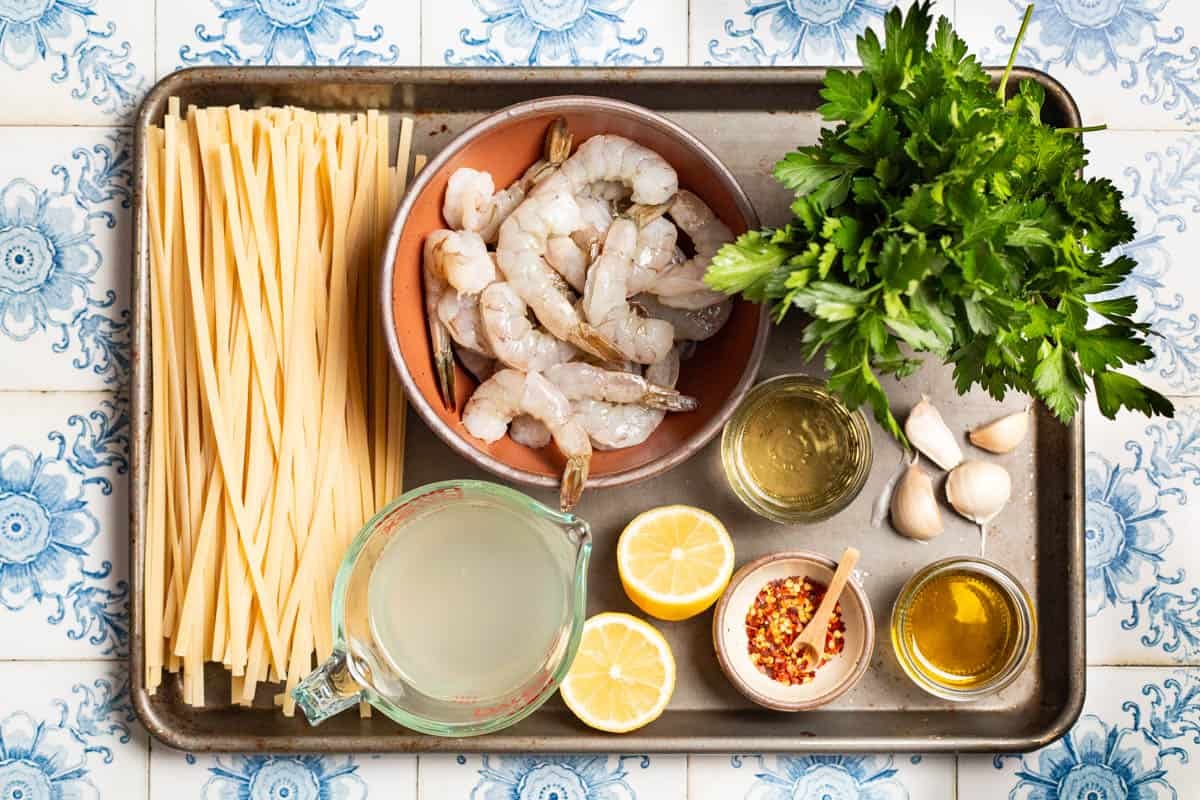
Shrimp Linguine Ingredients
Just a few simple ingredients combine to make this stellar pasta dish. As with all Italian dishes, quality matters, so be sure to buy your seafood from a reputable source.
- Shrimp: Opt for large shrimp (not jumbo) in their shell.
- Extra-virgin olive oil: Choose a good Italian olive oil that is fresh, with rich, buttery notes, like our Nocellara.
- Aromatics: Garlic, sliced paper-thin, and a pinch of red pepper flakes, add lots of zing to this dish, so be generous. I typically use just one or two cloves of garlic in my pasta dishes, but for this one I up the quantity to four. It sounds like too much, but really it’s just enough.
- Dry white wine: An inexpensive but good wine is what you want for this dish. Pinot Grigio, Soave, or Pecorino are all excellent choices.
- Broth: To help create a brothy sauce in which to cook the shrimp, I add either bottled clam juice, seafood stock, or chicken broth, depending on what I have in my pantry. You can make your own broth with our Homemade Chicken Stock recipe, or use a high-quality store-bought variety.
- Lemon juice and zest: A good squeeze of lemon juice, plus some finely grated zest, contributes bright tangy notes to the pan sauce.
- Parsley: A shower of finely chopped flat-leaf parsley stirred in at the end of cooking and sprinkled on top brings a splash of color and herby zest to complete the recipe.
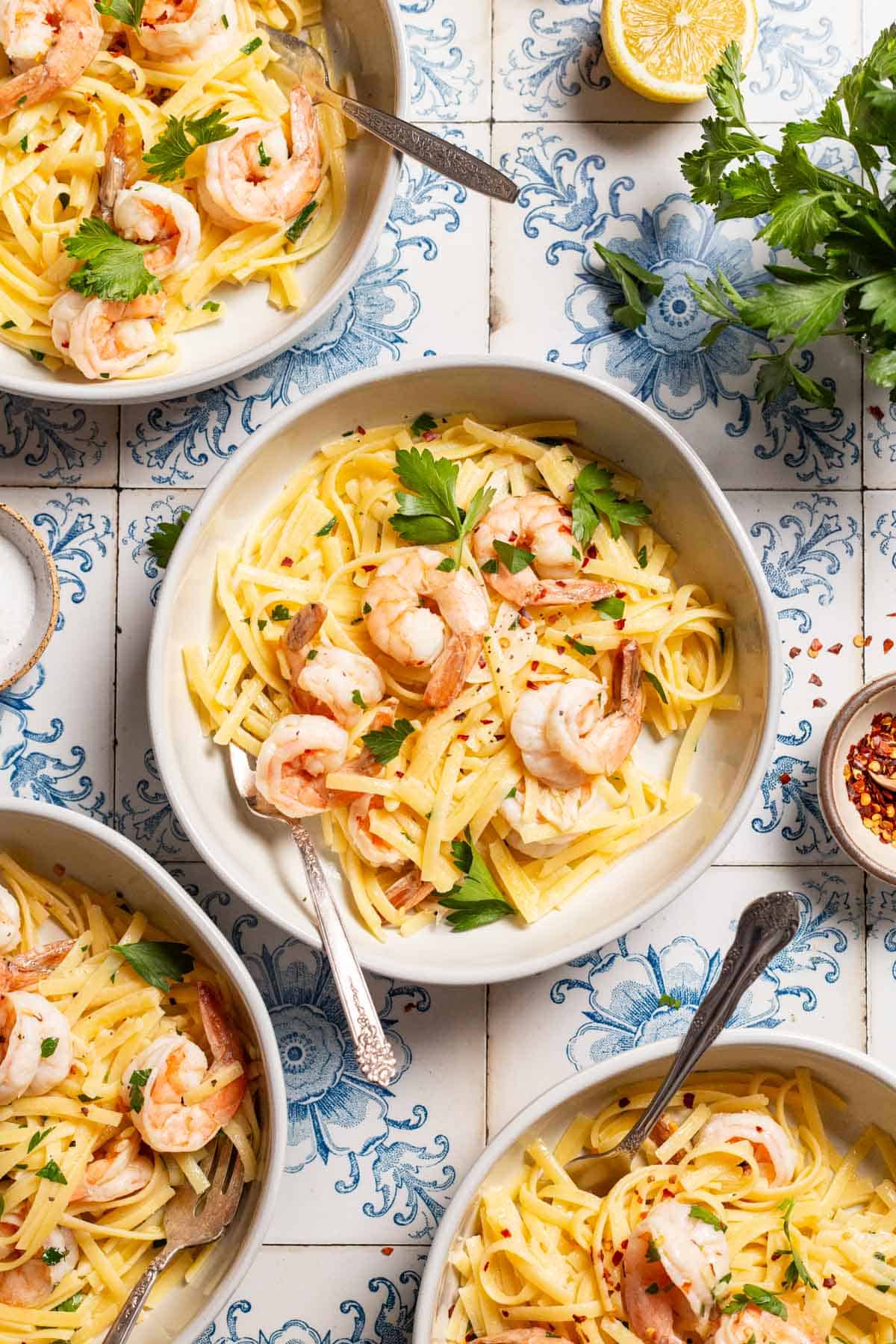
Ingredient Spotlight
Large shrimp is my preferred size for pasta, rather than jumbo or colossal. They provide the best balance between seafood and noodles and they are a high-protein, low-calorie option. A 3-ounce portion of shrimp has about 20 grams of protein and only 100 calories. If you can, look for:
- Fresh shrimp still in their shells rather than shrimp that have already been peeled and deveined. The shell preserves the shrimp’s moisture and freshness.
- Choose wild or sustainably farmed shrimp for the best quality. You can use frozen shrimp for this recipe, but, again, look for high-quality wild or sustainably farmed.
- READ MORE: Guide to Buying and Cooking Shrimp
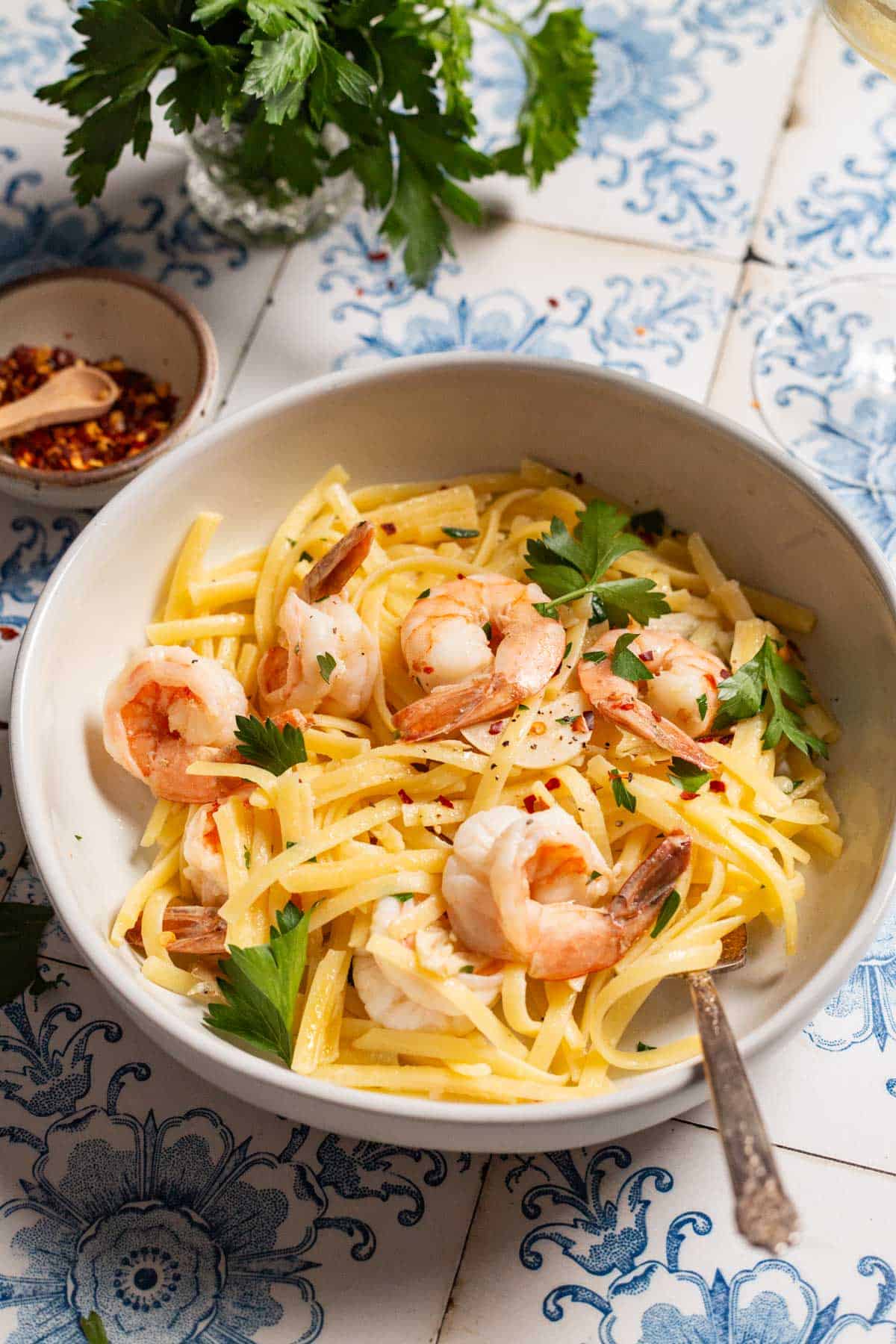
How to Make Shrimp Linguine
This shrimp linguine recipe could not be simpler. The most challenging task is cleaning and deveining the shrimp, and even that is a quick chore if you’ve got a shrimp peeler handy.
Peel and Devein the Shrimp
- If you’re using frozen shrimp: thaw. Remove as many shrimp as you plan to cook (18-24) and put them in a zip-top bag. Seal the bag well, then place the bag in a bowl of cold water set in the sink. Place a weighted object, such as a plate, lid, or another bowl, on top of the bag of shrimp to keep it submerged. Let sit for about 30 minutes, until thawed.
- Peel the shrimp: If the head is attached, just twist and pull it off. I’ve used a shrimp peeler for years, but if you’re working with your hands, pull off the small legs from the bottom of the shrimp. Hold the shrimp by the tail and use your fingers to crack open and peel away the shell starting at the head end. As you reach the tail, use your other hand to keep the small tail section attached as you peel (or you can remove the tail too if you’d like.) You can also use kitchen shears or a small paring knife to cut the peel away from the shrimp flesh.
- Devein the shrimp: If there is a black vein running along the back of the shrimp that the peeler has not removed, use your fingers or the tip of a paring knife to pull it out, and discard it. Transfer the shrimp to a clean plate or bowl as you clean them and discard the shells.
Cook the Pasta and Make the Pan Sauce
- Put a pot of water on to boil: Fill a large pot with enough water to submerge the pasta.
- Get the sauce going: Pour 3 tablespoons extra virgin olive oil into a cold skillet large enough to hold the cooked linguine. Slice four cloves of garlic paper-thin (Goodfellas-style); or, if you prefer an even stronger garlicky flavor, chop the cloves to a fine mince. Add the garlic to the skillet and set the heat to medium-low to soften the garlic for 2 to 3 minutes. Stir in 1/2 teaspoon red pepper flakes.
- Add liquids to the pan: Raise the heat to medium-high and pour in 1/2 cup dry wine. Let it bubble for 3 to 4 minutes, until slightly reduced. Then, pour in about 3/4 cup clam juice, seafood stock, or chicken broth, and simmer for another 3 to 4 minutes to slightly reduce the sauce once more. Season with a generous pinch of salt and continue to simmer, stirring for another minute.
- Boil the pasta: Season the boiling water with salt, then drop in 16 ounces of linguine pasta. Turn the heat to medium-high and cook according to package instructions until the pasta slightly underdone—very al dente. Reserve about 1 cup of the water, then drain.
- Cook the shrimp and finish the pan sauce while the pasta cooks: Add the shrimp to the liquid in the skillet and poach over medium heat for 2 minutes per side. Add the zest of one small lemon and 2 to 4 tablespoons lemon juice and stir to combine. Cook the shrimp for another minute or so, until pink and cooked throughout. Transfer the shrimp to a bowl and cover to keep warm.
- Make a pan sauce. Raise the heat in the skillet to medium-high and simmer until the juices have reduced and thickened slightly. The sauce should still be brothy.
Finish and Serve
- Dress the pasta in the sauce. Transfer the slightly undercooked linguine to the skillet using tongs or a pasta fork. Swirl the pasta around in the sauce and cook until the noodles are al dente and have absorbed most, but not all, of the sauce. The sauce will have thickened by this point, so add another 1/4 cup clam juice or broth, if needed, or a splash of the reserved pasta water, until the noodles are cooked through. Sprinkle in 2 tablespoons of chopped parsley leaves and stir to combine.
- Serve. Transfer the pasta to individual bowls. Top each serving with shrimp and a sprinkle of chopped parsley and serve. Or, if you’d like to serve it family-style, transfer the pasta to a serving platter and arrange the shrimp on top. Sprinkle with the remaining chopped parsley and serve.
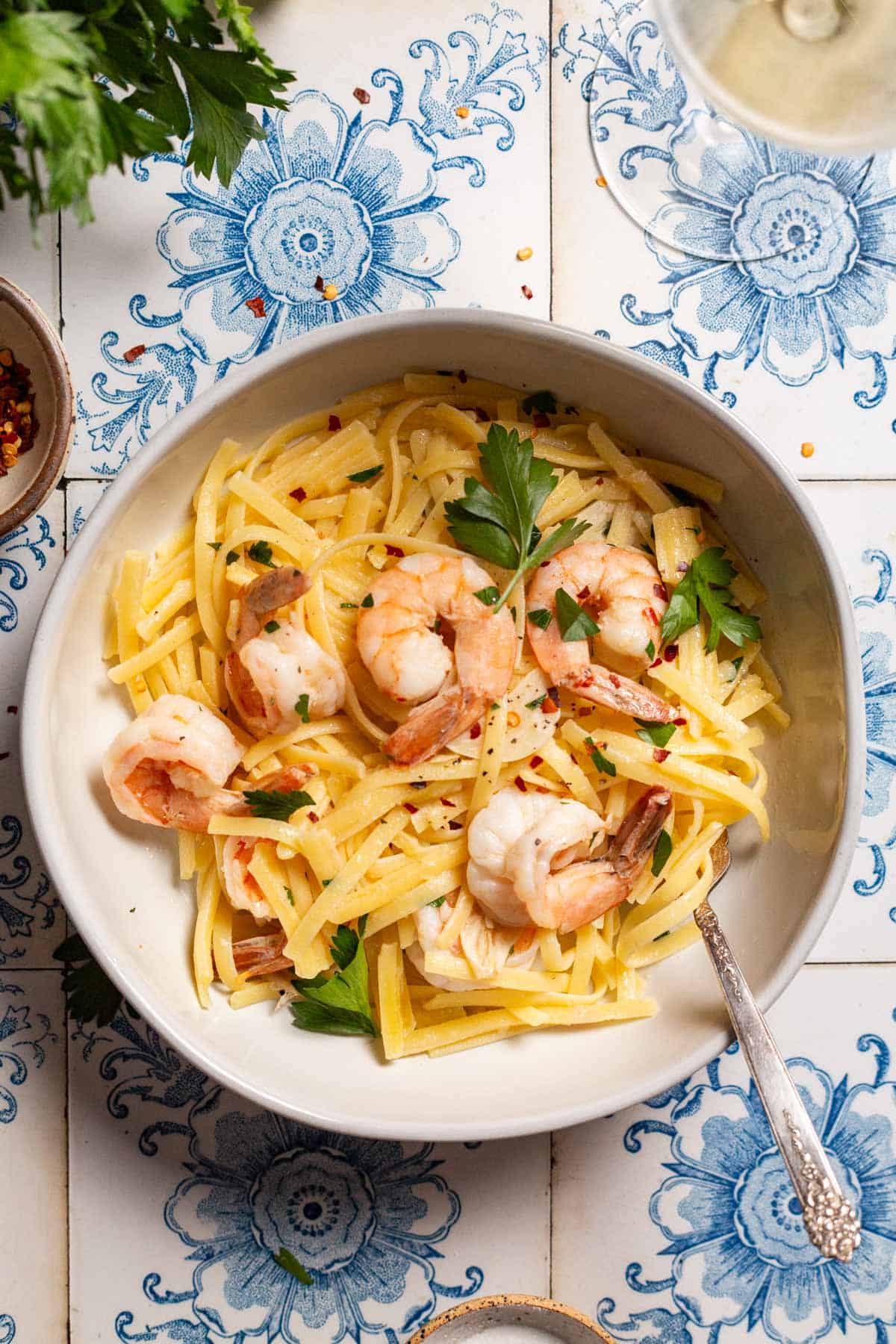
Ways to Mix it Up
Just because garlicky shrimp and linguine are a classic combination doesn’t mean you can’t play around with the recipe! Here are some ways to mix it up.
- Add cherry tomatoes: Stir a cup of halved cherry tomatoes into the olive oil and garlic after the garlic has softened. Let them cook for about 5 minutes over medium heat until they are somewhat softened. Use a slotted spoon or skimmer to transfer them to a plate and cover to keep warm while you finish cooking the pasta and shrimp. Right before serving, return the tomatoes to the skillet and toss with the cooked pasta and sauce.
- Skip the wine: If you prefer not to add wine, simply leave it out and substitute a little more broth and lemon juice. You can also use a little more of the pasta cooking water if necessary to loosen the sauce.
- Add breadcrumbs. Toss about 1/2 cup breadcrumbs with a drizzle of olive oil and fry in a small skillet until crisp. Sprinkle breadcrumbs on top of each serving.

What to Serve with Shrimp Linguine
Shrimp and broccoli are always a good combination, so I like to serve this Shrimp Linguine recipe with a side of Roasted Broccoli with Lemon.
A crunchy Lemony Fennel Salad with Shaved Parmesan and Walnuts would also be delicious. If you’re in the mood for dessert but want to keep it light, try this fresh and colorful Citrus Salad with Honey and Vanilla.
You’ll Also Like: More Shrimp Pasta Recipes
Browse all Mediterranean recipes.
Visit Our Shop
Try Our Authentic Italian Olive Oil
Hand-picked and cold extracted Extra Virgin Olive Oil from 100% Nocellara del Belice Sicilian olives.
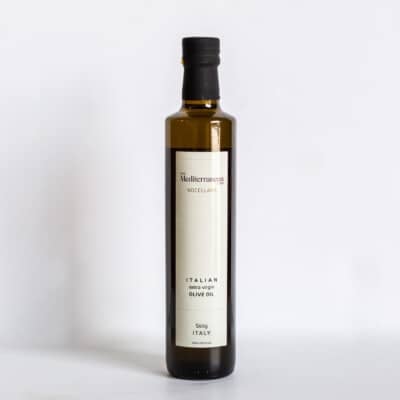
Shrimp Linguine
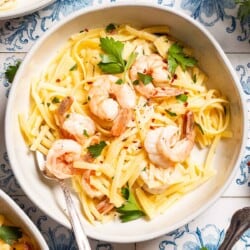
Ingredients
- Kosher salt
- 3 tablespoons extra-virgin olive oil
- 4 garlic cloves, sliced paper-thin (or finely minced for a stronger flavor)
- 1/2 teaspoon crushed red pepper flakes, or to taste
- 1/2 cup dry white wine, such as Pinot Grigio, Soave, or Pecorino
- 3/4 to 1 cup bottled clam juice, seafood stock, or chicken broth
- Zest of 1 small lemon, plus 2 to 4 tablespoons freshly squeezed juice (from 2-3 lemons)
- 18 to 24 large shrimp, peeled and deveined (about 1 pound)
- 1 pound linguine
- 3 tablespoons finely chopped fresh flat-leaf parsley
Instructions
- Put the pasta water on to boil. Fill a large pot with water and set it over high heat. Bring to a boil, then add 2 teaspoons salt.
- Meanwhile, start the sauce. In a large, wide skillet, add the olive oil and garlic. Set over medium-low heat and cook, stirring, until the garlic is softened and aromatic, about 3 minutes. Stir in the red pepper flakes.
- Add the liquid. Raise the heat to medium-high and pour in the wine. Let it bubble for 3 to 4 minutes, until slightly reduced. Then pour in 3/4 cup of clam juice or broth and simmer for another 3 to 4 minutes to slightly reduce the sauce once more. Season with 1/2 teaspoon salt and continue to simmer, stirring for another minute.
- Cook the pasta. Add the pasta to the boiling salted water. Turn the heat to medium-high and cook according to package instructions until the pasta slightly underdone—very al dente. Save a cup’s worth of the pasta’s cooking water before draining.
- Meanwhile, cook the shrimp and finish the pan sauce. While the pasta cooks, add the shrimp to the skillet with the broth and poach over medium heat for 2 minutes per side. Add the lemon zest and juice and stir to combine. Cook the shrimp for another minute or so, until pink and cooked throughout.
- Make a pan sauce. Transfer the shrimp to a bowl and cover to keep warm. Raise the heat in the skillet to medium-high and simmer another minute or two until the juices have reduced and thickened slightly. The sauce should still be brothy—the pasta will finish cooking in it.
- Dress the pasta in the sauce: Transfer the slightly undercooked linguine to the skillet and, using tongs or a pasta fork, swirl the pasta around in the sauce and cook for 3 to 4 minutes, or until the noodles are al dente and thoroughly coated with sauce. The sauce will have thickened by this point, so add another 1/4 cup clam juice or broth, if needed, or a splash of the reserved pasta water, until the noodles are cooked through. Sprinkle in 2 tablespoons of the parsley and toss to incorporate.
- Serve: Transfer the pasta to individual bowls. Top each serving with shrimp and a sprinkle of chopped parsley and serve. Or, to serve it family-style, transfer the pasta to a serving platter and arrange the shrimp on top. Sprinkle with the remaining chopped parsley and serve.
Notes
- If you’re using frozen shrimp: Remove as many shrimp as you plan to cook and put them in a zip-top bag. Seal the bag well, then place in a bowl of cold water set in the sink. Place a weighted object, such as a plate, lid, or another bowl, on top of the bag to keep it submerged. Let sit for about 30 minutes, until thawed.
- Visit our shop to browse quality Mediterranean ingredients including olive oils, honey, jams, and spices.
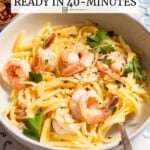

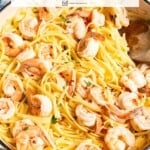
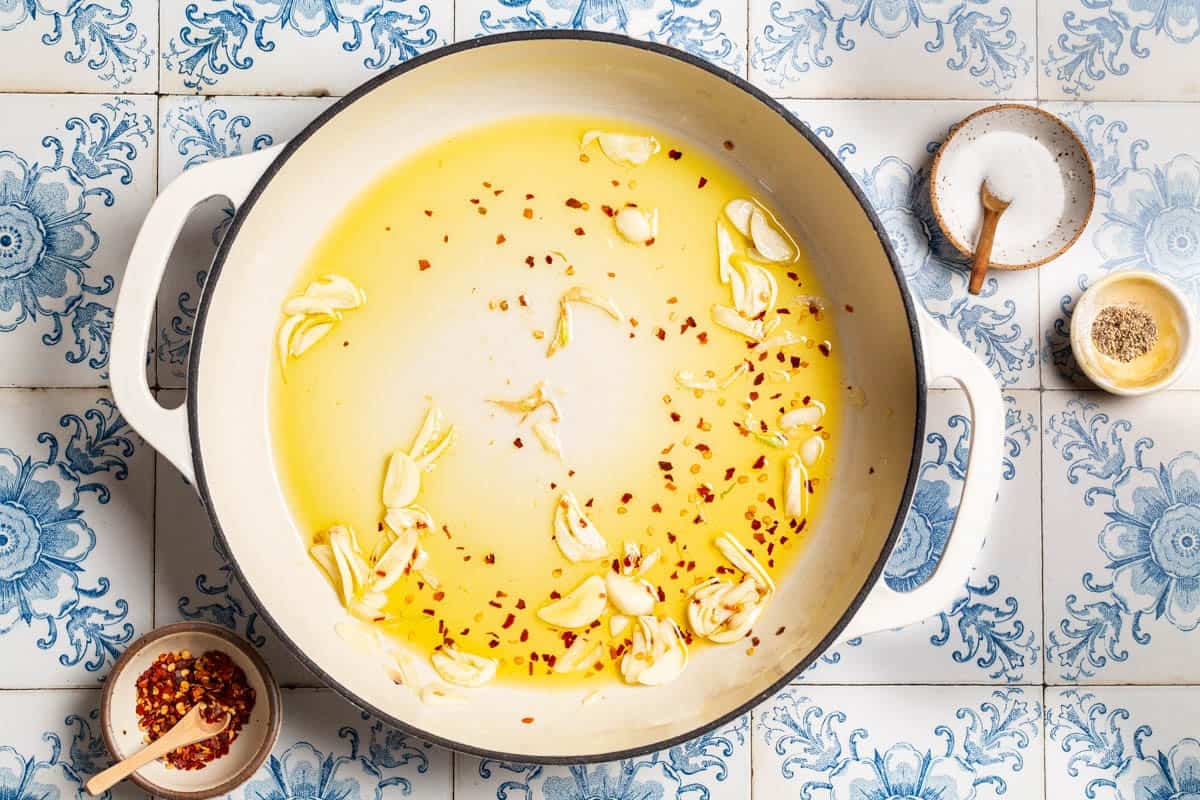
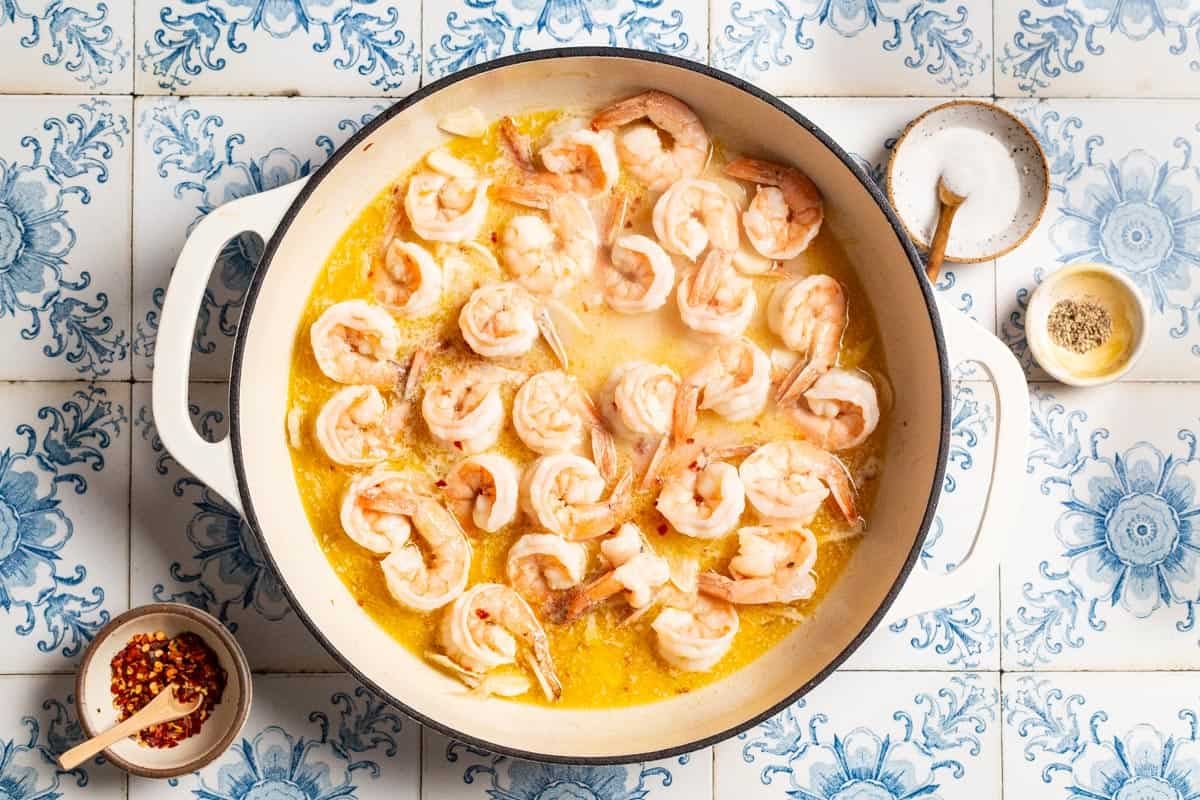
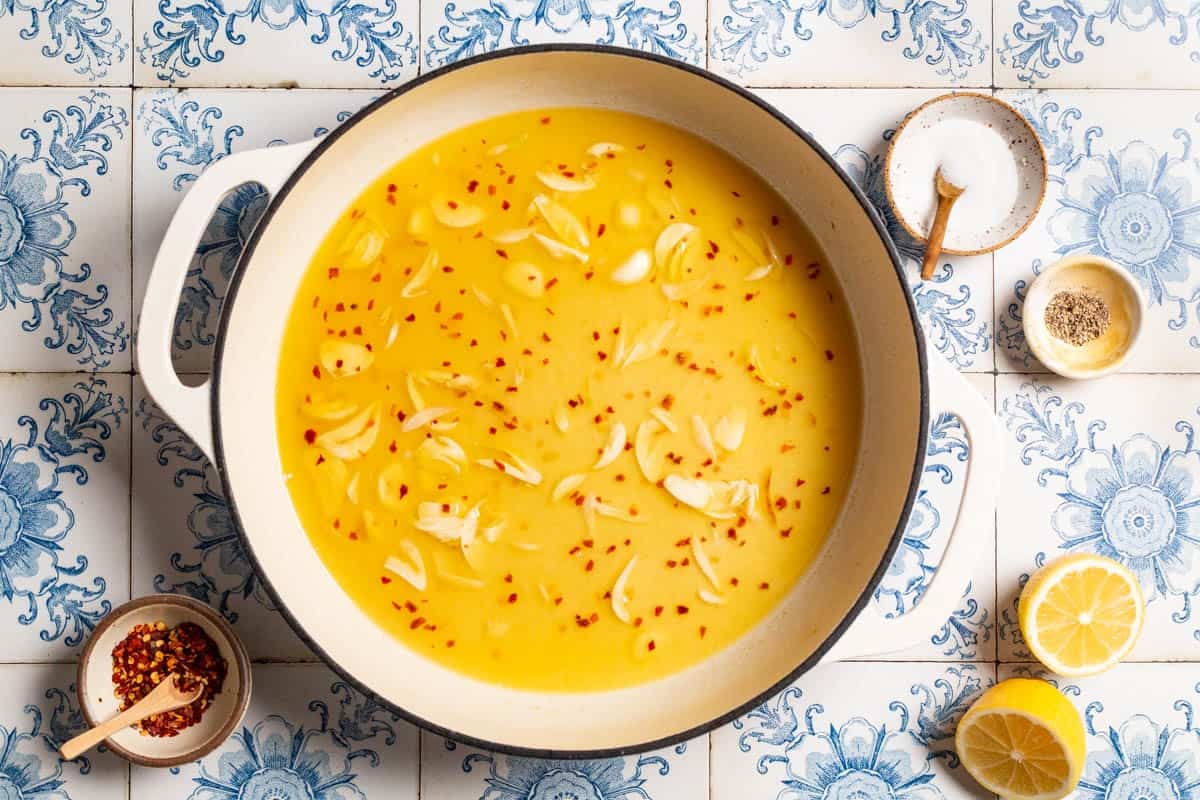
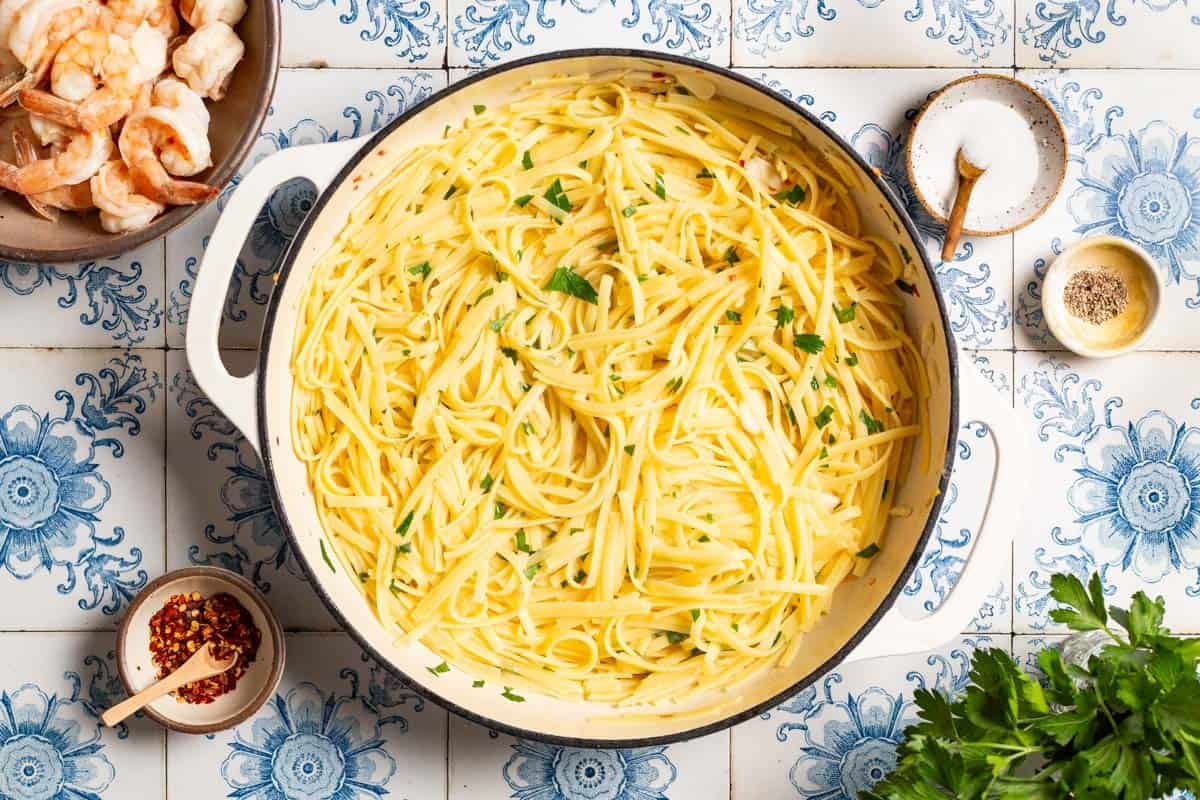
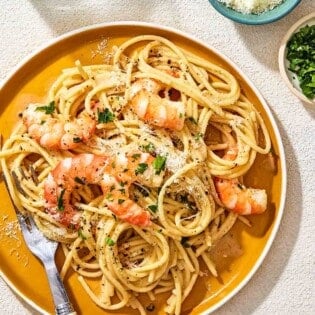
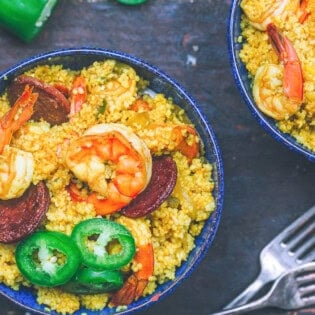
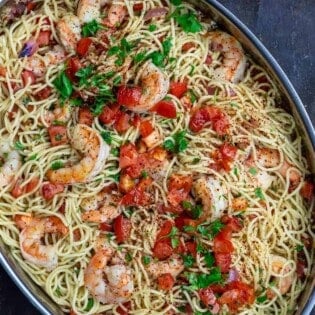
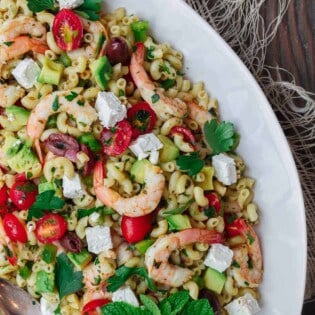
I am delighted that I found this site, exactly the right information that I was looking for! .
We love to hear this, Luke! Thank you!
Made this the other night; used fresh pasta and no salt, chicken stock for clam juice. It was delicious, my wife and I couldn’t stop eating it. Will make this again and again. So rich and creamy, but no cream. Simple and good, 5 stars!
I’ll bet this was amazing with fresh pasta! Yum!
This sounds delish
Do you think I could make it with scallops instead of shrimp?
Absolutely! You can use our Scallop Pasta recipe as a bit of a guide, if needed. Enjoy!
This looks very good but why suggest chicken broth? I always save the shrimp skins in the freezer so I can make a simple stock with shells and aromatics. It supports the shrimp and uses something that would otherwise go to waste.
That’s a great idea, Meredith! We just recommend chicken broth as its most often what most people have on hand or can pick up easily from their local market.
Delicious
Thanks so much, Louise.
Your recipes sound and look so good. Anxious to try some 0f them.